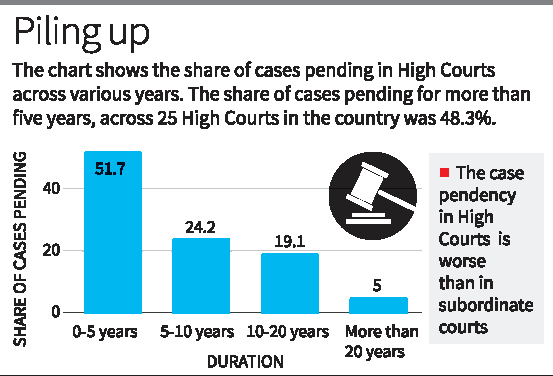Description

Copyright infringement not intended
Context: According to the India Justice Report, judicial vacancies remain high, and cases grow in number.
India Justice Report 2022
About
- Tata Trusts launched the India Justice Report (IJR) in 2019, and this is the third edition.
- The Centre for Social Justice, Common Cause, Commonwealth Human Rights Initiative, DAKSH, TISS-Prayas, Vidhi Institute for Law Policy, and How India Lives, IJR's data partner, are among the foundation's partners.

Parameters
- This study relies on overall statistics from four pillars of justice delivery:
- Police
- Judiciary
- Prisons
- Legal aid
- Each pillar was examined through the lens of finances, human resources, workload, diversity, infrastructure, and trends in comparison to the state's own proclaimed norms and benchmarks.
Highlights of the Report
Shortage of Judges
- As of December 2022, the High Courts were operating with just 778 judges, despite a sanctioned strength of 1,108.
- The subordinate courts were reported to be operating with 19,288 judges, despite a sanctioned strength of 24,631 judges.
Increasing Pendency
- In most states, the number of cases pending per judge has increased over the last five years, although the sanctioned strength has stayed relatively constant.
- At the High Court level, Uttar Pradesh has the longest average pendency; cases are pending for an average of 11.34 years, while West Bengal has a pendency of 9.9 years. Tripura has the lowest average High Court pendency (1 year), Sikkim (1.9 years), and Meghalaya (2.1 years).
Case Clearance Rate (CCR)
- A typical statistic used to estimate the pace at which cases are disposed of is the case clearing rate (CCR) or the number of cases disposed of in a year divided by the number of cases filed in that year.
- A CCR greater than 100% shows that the number of outstanding cases is decreasing.
- According to the report, the High Courts are solving more cases than the subordinate courts. Between 2018-19 and 2022, the national average in High Courts increased by six percentage points (88.5% to 94.6%) but decreased by 3.6 points (93% to 89.4%) in Subordinate courts.
- The High Courts of Kerala and Odisha have the highest case clearance rates — 156% and 131%, respectively — while the High Courts of Rajasthan (65%) and Bombay (72%), respectively, have the lowest.

Court Halls
- Nationwide, the number of courtrooms looks to be sufficient to accommodate the number of real judges. But it stressed that if all of the sanctioned positions are filled, space will become an issue.
- According to the study, there were 21,014 court halls in August 2022 for the 24,631 judges' posts sanctioned at the time, a 14.7% shortage.
- There were no court halls for the 86, 82, and 35 serving judges in Delhi, West Bengal, and Uttarakhand, respectively.
- If every state appointed each of its sanctioned judges, there would only be four states and four union territories with enough court buildings. There would be a greater than 25% gap in 11 states/union territories, according to the report.
Performance of States
- Large States: Karnataka has moved to first place among the 18 major and mid-sized states with populations of over one crore in terms of justice delivery, which includes the police, judiciary, prisons, and legal aid.
- Tamil Nadu came in second place, with Telangana coming in third. Uttar Pradesh is ranked 18th, which is the lowest.
- Small States: Sikkim led the list of Seven Small States having a population of less than one crore, followed by Arunachal Pradesh. Goa ranked seventh, the lowest.

Keywords
Subordinate courts
- In every state of India, the High Court is the top-most judicial body. Below the High Court, though, other courts make up the subordinate judiciary. These are known as subordinate courts.
- Subordinate courts are subordination to the state high court. They are; Civil courts, Criminal courts and Revenue courts
- The state's High court exercises jurisdiction over the subordinate courts. The High Court of a state has the authority to withdraw a matter pending before any subordinate court.
- The High Court also has total jurisdiction and supervision over subordinate court personnel and officers.
Must Read Articles:
Vacancies in High Courts: https://www.iasgyan.in/daily-current-affairs/vacancies-in-high-courts
Pendency in High Courts: https://www.iasgyan.in/daily-current-affairs/pendency-in-higher-courts
Pendency of Court Cases in India: https://www.iasgyan.in/rstv/pendency-of-court-cases-in-india
|
PRACTICE QUESTION
Q. In light of the Recently released India Justice Report 2022, discuss the possible reasons behind the increasing pendency of cases at all levels of the Judiciary. Also, suggest innovative steps to reduce the pendency and ensure speedy justice and an efficient Judicial system for the Common man.
|

https://epaper.thehindu.com/ccidist-ws/th/th_delhi/issues/31319/OPS/GOPB2RUSM.1+GNAB2SL0T.1.html
















